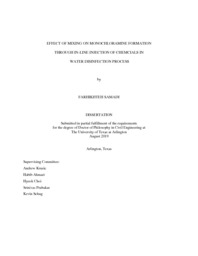
ATTENTION: The works hosted here are being migrated to a new repository that will consolidate resources, improve discoverability, and better show UTA's research impact on the global community. We will update authors as the migration progresses. Please see MavMatrix for more information.
Show simple item record
| dc.contributor.advisor | Kruzic, Andrew | |
| dc.creator | Samadi, Farhikhteh | |
| dc.date.accessioned | 2022-01-20T17:33:14Z | |
| dc.date.available | 2022-01-20T17:33:14Z | |
| dc.date.created | 2019-08 | |
| dc.date.issued | 2019-08-01 | |
| dc.date.submitted | August 2019 | |
| dc.identifier.uri | http://hdl.handle.net/10106/30128 | |
| dc.description.abstract | Addition of chlorine and ammonia to water for monochloramine formation in the secondary disinfection process in treatment plants has some challenges. Monochloramine formation as the only desirable product of the chloramination process is affected by several factors. These factors are pH, chlorine to nitrogen ratio and chemical mixing. In this study an investigation was conducted to measure the effect of mixing on monochloramine formation through direct injection of chemicals in a pipeline when keeping the other factors constant.
In this study two sets of experiments were conducted. In the first study a tracer salt testing was used to find a measure for mixing in the pipeline and that measure was used to discover a point/section in the pipeline where complete mixing was achieved in the cross section of the pipe. For measuring physical mixing in the pipeline, tracer salt was injected into two injection locations, that were chosen to be upper wall and centerline of the pipe. Samples were collected into 50 cylinders at 6 different distances from the injection point using a pitot tube. The conductivity of the samples was measured immediately and COV of the conductivities were calculated as a measure of mixing. At each of the sampling points, 50 samples were collected in 5 points across the pipeline to have a representative value for salt conductivity in the cross section of the pipe. The results showed that centerline injection of tracer salt led to complete mixing 52 ft after injection point in the downstream of the straight pipeline at all velocities. In each step, velocity of water in the pipeline was increased to improve turbulence and reduce retention time in the pipeline. This change, improved COV values, resulting in better mixing of the tracer salt over a shorter time.
After assessing the effect of increase in flow velocity on mixing by tracer salt study in a straight section of pipeline, bends were added to the pipeline for tracer salt study. It was expected to see better mixing in shorter distance and less travel time, because of the addition of bends to the mainstream pathway. The results were in accordance with the expectations and bends improved physical mixing of the secondary flow with the main flow. Complete mixing was achieved in the order of seconds after salt injection.
In the next phase the result from first phase were used for chemical sampling. The section in which complete mixing was achieved in the downstream of the pipeline, was chosen as a sampling location for chloramination study and samples were collected even further down from that point to compensate for any errors in the experiments. Chlorine and ammonia solutions were injected into the upstream of the pipeline. Two sources of chlorine were used to asses effect of dilution ratio on monochloramine formation. Water samples were also collected in amber bottles for manual chemical addition and mixing to imitate well mixed condition as batch tests. The results showed that there was a difference in monochloramine values from batch test and pipeline samples in all four flow velocities. The batch test led to formation of higher concentration of monochloramine, because better mixing was achieved within a few seconds after the chemicals were added to the bottle which was provided immediately by shaking the bottles manually.
Effect of addition of bends on the chemical mixing process was also examined by adding bends to the path of chemicals that were being injected into the pipe. It was observed that despite improvements in providing a better physical mixing in a shorter time, monochloramine recovery did not enhance through bends. | |
| dc.format.mimetype | application/pdf | |
| dc.language.iso | en_US | |
| dc.subject | Water disinfection | |
| dc.subject | Chloramination | |
| dc.subject | Mixing | |
| dc.subject | Water treatment | |
| dc.subject | In-line injection | |
| dc.title | Effect of Mixing on Monochloramine Formation through In-line Injection of Chemicals in Water Disinfection Process | |
| dc.type | Thesis | |
| dc.degree.department | Civil Engineering | |
| dc.degree.name | Doctor of Philosophy in Civil Engineering | |
| dc.date.updated | 2022-01-20T17:33:15Z | |
| thesis.degree.department | Civil Engineering | |
| thesis.degree.grantor | The University of Texas at Arlington | |
| thesis.degree.level | Doctoral | |
| thesis.degree.name | Doctor of Philosophy in Civil Engineering | |
| dc.type.material | text | |
| dc.creator.orcid | 0000-0001-7130-9572 | |
Files in this item
- Name:
- SAMADI-DISSERTATION-2019.pdf
- Size:
- 2.153Mb
- Format:
- PDF
This item appears in the following Collection(s)
Show simple item record


